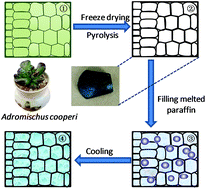Leakage-proof phase change composites supported by biomass carbon aerogels from succulents†
Abstract
The practical applications of organic phase change materials (PCM) are greatly limited, due to their leakage in the melted state and unacceptably low thermal conductivity. To address such a challenge, we use a succulent-based carbon aerogel (SCA), which consists of the epidermis, palisade tissue and spongy tissue, as an encapsulation scaffold for paraffin to fabricate PCM composites. The spongy tissue consisting of rich closed spherical cells allows a high loading efficiency (up to 95 wt%) for organic PCM, while the tightly-arranged palisade tissue and dense epidermis cells can act as two protective layers to prevent the leakage of liquid, enabling a mass loss as low as 1.3 wt% upon phase change. The PCM composites also show a high latent heat approaching that of pure paraffin and an excellent thermal cycling performance with 100% retention after being tested by using a differential scanning calorimeter 20 times. Moreover, the SCA not only serves as thermal conductive paths within the organic matrix, thereby remarkably enhancing the thermal conductivity of the PCM composites, but also acts as an effective photon captor and molecular heater, thus significantly increasing the light-to-thermal energy conversion efficiency of the PCM composites. As such, the SCA is an ideal multifunctional scaffold for PCM, which can advance the practical applications of PCM composites.



 Please wait while we load your content...
Please wait while we load your content...